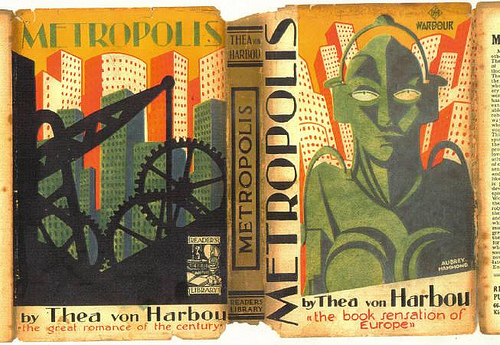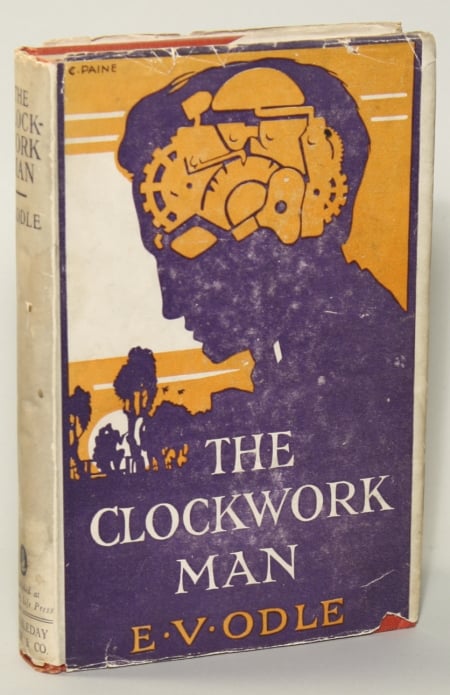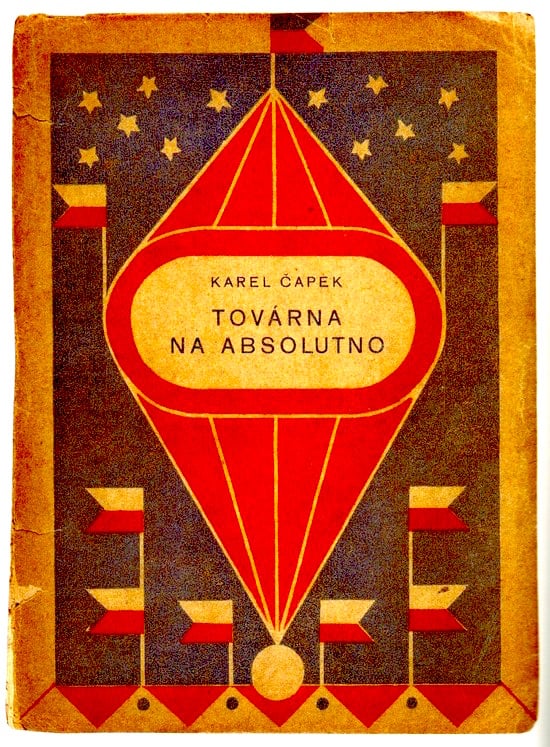Radium Age Redux
By:
June 10, 2016

Not long ago, we wrapped up the RADIUM AGE 100 series, via which HILOBROW’s Josh Glenn attempted to identify the best science fiction novels published during the (1904–1933) era that he has named the genre’s Radium Age. We kicked off the series in May 2015, and we finished it in April 2016. Phew! The complete list of 100 titles can be found here.
In May, over at Ars Technica, Annalee Newitz wrote a very nice story about the RADIUM AGE 100 series. Excerpt: “To appreciate these novels, you have to reverse-engineer their historical context and realize that the bomb had not yet dropped and the Soviet Union hadn’t yet coalesced into an authoritarian regime. Imagine a world where we were hopeful about the future because we had no fear of weapons of mass destruction. And where we had not yet seen what fascism would do to the West but were still deeply worried about it. Instead of bombs, the spectre of World War I haunts many of these books with its senseless, overwhelming violence; there’s a good reason why some of them imagine poison gas as the ultimate horror. The Radium Age was also a time when unionization and strike violence were a part of everyday life in industrialized cities, and these conflicts gave rise to fantasies about what would happen when robots took over manual labor. Robot uprising stories begin during the Radium Age, when worker uprisings were changing the social landscape.”
The article quotes Josh extensively:
One thing that distinguishes Radium Age from Golden Age science fiction is its faith in the possibility of a post-scarcity, peaceful, tolerant, just social order. For excellent historical reasons, we became very cynical about utopianism after Stalin and Hitler; Golden Age writers prided themselves on being wised-up, compared to their naive predecessors.
But the Radium Age wasn’t naive: We find many warnings about dystopian tendencies in the cultural, political, and economic tendencies of the period: Karel Capek and Aldous Huxley worried about the drive towards efficiency in all things that characterized both America and the USSR; Yevgeny Zamyatin and Edgar Rice Burroughs worried about the effects of Soviet-style collectivism on the individual; and Jack London’s “The Iron Heel” (1908), which is about fascist plutocrats who take over America, feels particularly relevant right now.
We also find optimism that people can overcome their worst tendencies and build something wonderful together: Rudyard Kipling’s “With the Night Mail” and Hugo Gernsback’s “Ralph 124C 41+” are technocratic utopias, Alexander Bogdanov’s “Red Star” portrays a successful socialist society on Mars; Charlotte Perkins Gilman’s “Herland” portrays a successful socialist society without men. (The evolving role of women is a key theme and sub-theme in Radium Age science fiction, too.)
With the benefit of hindsight, we can find problems with these utopias, there’s no doubt about that. But they’re admirable efforts of the imagination, too. My takeaway: While remaining cautious about totalizing visions of social harmony, we shouldn’t conflate “idealistic” with “naive,” nor consider it the opposite of “wised-up.” Radium Age sci-fi is both wised-up and idealistic.
Thanks, Annalee!

As Josh notes in the introduction to the official RADIUM AGE 100 homepage, putting this series together was his way of bidding farewell to the larger Radium Age Science Fiction project, which began in 2008 when he was invited to contribute a series of posts to the sci-fi blog io9.com.
Josh has helped raise awareness about unfairly overlooked Radium Age science fiction by writing about the era for the scientific journal Nature, Boing Boing, and elsewhere; and by reissuing 10 science fiction novels from that period under HiLoBooks’s purpose-built Radium Age Science Fiction imprint. (Don’t want to pay for public-domain lit? OK! HiLobrow serialized all 10 of these books; they’re freely available via this page.) The Radium Age Science Fiction project has been a labor of love, and now Josh is ready to move on to other projects… including a new series of posts on the 75 best science fiction novels from the genre’s so-called Golden Age.

We’re also grateful to sci-fi author Cory Doctorow, who in June wrote a Boing Boing item about the RADIUM AGE 100 series. “For nearly a decade, science fiction historian Joshua Glenn has waged a campaign to resurrect the ‘Radium Age’ of science fiction: the period from 1904-1933 when writers turned their pens to ‘Air Battles, Antigravity, Interplanetary Voyages, Lost Worlds, Mad Scientists, Time Travel, and Utopias,’ before writers like Andre Norton and Arthur C Clarke and Isaac Asimov began their careers.”
And thanks, too, to Leah Schnelbach, for the Tor.com post about the RADIUM AGE 100 series. She wrote, about science fiction’s Radium Age: “The era lasted between 1904 and 1933, which stands out for its peculiar blend of science, optimism, and occultism — all of which was tempered by the horrors of the First World War. This led to some truly weird and fascinating works of science fiction.”
Hopefully, this little flurry of publicity for the Radium Age Science Fiction project will persuade new readers to pick up or download a sci-fi novel by Olaf Stapledon, William Hope Hodgson, Edgar Rice Burroughs, Sax Rohmer, Karel Čapek, Hugo Gernsback, E.E. “Doc” Smith, H.P. Lovecraft, Charlotte Perkins Gilman, Yevgeny Zamyatin, Rudyard Kipling, Jack London, Arthur Conan Doyle, David Lindsay, John Taine, Jack Williamson, S. Fowler Wright, Gustave Le Rouge, A. Merritt, Murray Leinster, Jean de La Hire, Maurice Renard, Philip Wylie, or one of the other talented Radium Age authors we’ve promoted so assiduously, for such a long time, here at HILOBROW. Enjoy!
MORE RADIUM AGE SCI FI ON HILOBROW: HiLoBooks homepage! | What is Radium Age science fiction? |Radium Age 100: 100 Best Science Fiction Novels from 1904–33 | Radium Age Supermen | Radium Age Robots | Radium Age Apocalypses | Radium Age Telepaths | Radium Age Eco-Catastrophes | Radium Age Cover Art (1) | SF’s Best Year Ever: 1912 | Radium Age Science Fiction Poetry | Enter Highbrowism | Bathybius! Primordial ooze in Radium Age sf | War and Peace Games (H.G. Wells’s training manuals for supermen) | Radium Age: Context series | J.D. Beresford | Algernon Blackwood | Edgar Rice Burroughs | Karel Čapek | Buster Crabbe | August Derleth | Arthur Conan Doyle | Hugo Gernsback | Charlotte Perkins Gilman | Cicely Hamilton | Hermann Hesse | William Hope Hodgson | Aldous Huxley | Inez Haynes Irwin | Alfred Jarry | Jack Kirby (Radium Age sf’s influence on) | Murray Leinster | Gustave Le Rouge | Gaston Leroux | David Lindsay | Jack London | H.P. Lovecraft | A. Merritt | Maureen O’Sullivan | Sax Rohmer | Paul Scheerbart | Upton Sinclair | Clark Ashton Smith | E.E. “Doc” Smith | Olaf Stapledon | John Taine | H.G. Wells | Jack Williamson | Stanisław Ignacy Witkiewicz | S. Fowler Wright | Philip Gordon Wylie | Yevgeny Zamyatin
